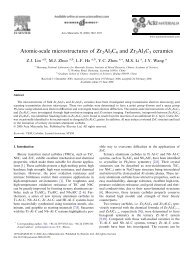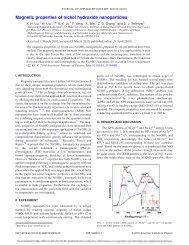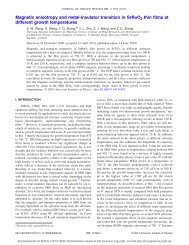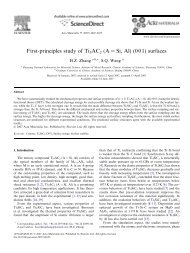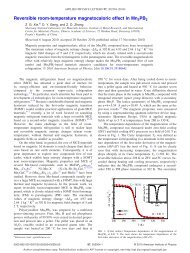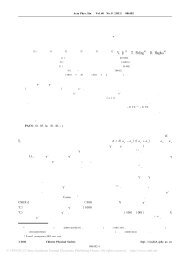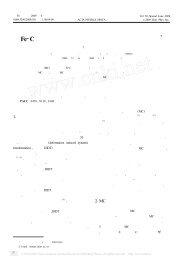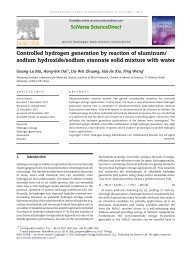830 J.W. Deng et al. / Micron 43 (2012) 827–831 Fig. 5. Summary <strong>of</strong> the peak variance V(k) values obtained using different nominal resolutions R for all tested amorphous materials. Table 2 Correlation lengths and characteristic widths W <strong>of</strong> the amorphous materials. The mean atomic radii, r, <strong>of</strong> the materials are listed, as well as ratios /r between the correlation lengths and the mean atomic radii. (nm) W (nm) r (nm) /r a-Si 3N 4 0.69 ± 0.055 2.2 0.096 7.2 Zr-S2 0.81 ± 0.35 2.6 0.15 5.4 Zr-Vit105 0.85 ± 0.34 2.7 0.15 5.7 Fe-BMG 0.88 ± 0.11 2.8 0.13 6.8 amorphous materials, and the greatest V(k) were obtained with the 0.6 nm resolution. 4. Discussion 4.1. MRO length <strong>of</strong> the amorphous materials The major advantage <strong>of</strong> <strong>variable</strong> resolution FEM is that it semiquantitatively determines MRO length <strong>of</strong> amorphous materials with no needs <strong>of</strong> prior knowledge on the material structure. By the use <strong>of</strong> pair persistence model (Gibson et al., 2000), the correlation lengths <strong>of</strong> the amorphous materials can be <strong>determined</strong> from the <strong>variable</strong> resolution FEM results. By assuming that the four-body atom correlation function g 4 has a Gaussian decay envelope, the variance V(k,Q) is transformed into following expression, ( Q 2 V(k, Q ) = 1 3 P(k) ) + ( 4 2 P(k) ) Q 2 . (2) is correlation decay length, which is closely related with the MRO length. The structure information independent on MRO length is separated into P(k), which is a pair persistence function. Accordingly, a linear correlation can be derived between Q 2 /V(k,Q) and Q 2 in low resolution (i.e. comparable to the MRO length scale <strong>of</strong> amorphous materials), and the correlation length is obtained as = 1 √ m 2 c , (3) where m = 4 2 /P(k) and c = 1/ 3 P(k) are the slope and intercept <strong>of</strong> the linear fitting <strong>of</strong> Q 2 /V(k,Q) against Q 2 (Fig. 6). Correlation lengths <strong>of</strong> the amorphous materials are presented in Table 2, where correlation lengths <strong>of</strong> BMGs are between 0.81 nm and 0.88 nm, which are considerably larger than that <strong>of</strong> a-Si 3 N 4 (∼0.69 nm). The measured correlation lengths are commonly significant smaller than the acknowledged MRO lengths in amorphous materials. A characteristic width W for MRO was proposed as W = √ 10 Fig. 6. Plot <strong>of</strong> the calculated Q 2 /V(k) against Q 2 values for all the amorphous materials according to the <strong>variable</strong> resolution FEM results. Here the V(k) values were chosen from Fig. 5. The corresponding Q values were listed in Table 1. Straight lines in different colors represent linear fitting to the data points. Using the slope and intercept <strong>of</strong> each fitting line, the correlation lengths <strong>of</strong> tested amorphous materials were extracted. <strong>by</strong> assuming as a radius <strong>of</strong> gyration for the correlated spheroidal <strong>order</strong>ed region (Gibson et al., 2000). In this work, W would be between 2.6 and 2.8 nm for BMGs, and ∼2.2 nm for a-Si 3 N 4 , which lies in the reported MRO <strong>range</strong> (0.5–3 nm) (Table 2). It is noteworthy that the pair persistence model predicts a monotonically decreasing V with the increase <strong>of</strong> R, which is inconsistent with our experimental results. Nevertheless, in <strong>order</strong> to compare with previous reported FEM results, we still used this method for the calculation <strong>of</strong> correlation lengths in this work. The obtained correlation lengths <strong>of</strong> a-Si 3 N 4 (0.69 nm) and BMGs (0.81–0.88 nm) are consistent with correlation lengths <strong>of</strong> amorphous materials <strong>determined</strong> in previous researches (e.g. 0.3–0.6 nm for a-Si (Bogle et al., 2010), 0.6–0.9 for CuZr (Hwang and Voyles, 2011)). Therefore, the calculation is reliable, although better understanding <strong>of</strong> the experimental results would need more advanced computation models as suggested <strong>by</strong> Stratton and Voyles (2008). 4.2. Size effect <strong>of</strong> objective aperture on the normalized intensity variance <strong>of</strong> FEM images As presented in Fig. 5, the highest variance V(k) peaks were all obtained when 0.6 nm resolution was employed (corresponding to 10 m objective aperture) for the amorphous samples in this work. This is probably due to the following reasons. In dark-field TEM imaging, the bright speckles arise from local <strong>order</strong>ed regions where coherent diffractions take place between structurally correlated atoms. In <strong>variable</strong> resolution FEM, the size <strong>of</strong> objective aperture determines the microscopy resolution in real space (proportional to 1/Q), which sets a lateral limit that the structurally <strong>order</strong>ed atoms can interfere coherently within. In this way, the size <strong>of</strong> objective aperture changes the sampling volume <strong>of</strong> dark-field imaging (Treacy and Gibson, 1996; Treacy et al., 2005). When the aperture size is appropriate, the obtained intensity variance value will reach a maximum because the sampling volume is comparable to the size <strong>of</strong> <strong>order</strong>ed region so that all structurally correlated atoms are contained in the sampling volume. A larger sampling volume (corresponding to smaller aperture) will include atoms outside an <strong>order</strong>ed region, thus decrease the obtained variance due to their incoherent interference. In contrast, a smaller sampling volume (larger aperture) will probe each <strong>order</strong>ed region multiple times, which also diminishes the variance value according to the
J.W. Deng et al. / Micron 43 (2012) 827–831 831 statistical feature <strong>of</strong> variance (Treacy, 2007; Treacy et al., 2005; Voyles and Abelson, 2003). Small objective apertures, which bring the nominal resolution R to the MRO length scale (0.5–3 nm), were suggested for FEM experiments to obtain reliable results (Treacy, 2007; Treacy et al., 2005). In this work, the correlation length is between 0.69 and 0.88 nm, while the characteristic width W is between 2.2 and 2.8 nm. This indicates that the maximum variance is obtained when the nominal resolution R approaches the correlation length rather than the characteristic width <strong>of</strong> MRO. This consists with recent <strong>variable</strong> resolution FEM experiment on Cu–Zr <strong>metallic</strong> glass in the STEM nanodiffraction mode (Hwang and Voyles, 2011). By changing the probe size, FEM resolution was adjusted in STEM. Their results show that the maximum variance values increase monotonically as the resolution goes down to 0.8 nm, which is significantly smaller than the MRO length usually accepted but close to the correlation length <strong>of</strong> their samples (0.68–0.89 nm). Unfortunately, since there is no experiment results for even smaller probe size, the downward trend <strong>of</strong> variance V(k) is not available for further decrease <strong>of</strong> the resolution in STEM. Compared with previous FEM works on a-Si, a-Ge, etc., much smaller resolutions have been used for the BMG and a-Si 3 N 4 samples in this study and these resolutions work adequately for the samples. Nevertheless, since different amorphous materials may have different MRO length scales, the appropriate resolution for samples in this work might not be the optimum condition for other materials. Hence, it is necessary to resolve the appropriate resolution for studied materials prior to conducting FEM experiments in TEM as suggested <strong>by</strong> Treacy (2007). This is in fact also a motivation for us to conduct the <strong>variable</strong> resolution FEM study here. 4.3. Comparison between MROs <strong>of</strong> <strong>metallic</strong> and covalent bond amorphous materials Although quantitative comparison <strong>of</strong> FEM results between different materials is hard due to influences from such as sample thickness, imaging conditions (Daulton et al., 2010; Yi and Voyles, 2011), a preliminary comparison <strong>of</strong> MRO lengths and magnitudes between covalent bond a-Si 3 N 4 and <strong>metallic</strong> bond BMGs is still possible especially when experiment configuration was kept consistent. Firstly, the variance peaks <strong>of</strong> BMGs are greater than that <strong>of</strong> a-Si 3 N 4 as shown in Fig. 5. Since the variance value corresponds to the extent <strong>of</strong> structural <strong>order</strong>ing, the greater variance indicates a higher <strong>order</strong>ing or an inhomogeneity in the BMG samples. Secondly, the correlation lengths <strong>of</strong> BMGs (0.81–0.88 nm) are larger than that <strong>of</strong> a-Si 3 N 4 (0.69 nm). However, in <strong>order</strong> to compare the MRO length in a relative scale, each correlation length was divided <strong>by</strong> the mean atomic radius r <strong>of</strong> the amorphous material (Table 2). Here, the mean atomic radius was calculated from Goldschmidt atomic radii <strong>of</strong> elements and chemical composition <strong>of</strong> each material (Gale and Totemeier, 2004). Although a-Si 3 N 4 has a much smaller correlation length, its /r value is in fact similar to or even slightly larger than that <strong>of</strong> BMGs. The spatial heterogeneity/homogeneity <strong>of</strong> BMGs on the nanoscale is also an interesting research topic. Researchers have suggested that the heterogeneity in BMG can play an important role during the initiation <strong>of</strong> shear bands and the subsequently plastic deformation process (Murali et al., 2011; Wang et al., 2012). However, the main focus <strong>of</strong> present work is to determine the length scale <strong>of</strong> medium <strong>range</strong> <strong>order</strong> in different amorphous materials. In <strong>order</strong> to reveal the structure character <strong>of</strong> heterogeneity in BMGs, which is beyond the scope <strong>of</strong> this work, more experiments and analysis would be needed. 5. Conclusions Variable resolution FEM has been successfully performed in TEM <strong>by</strong> varying the objective aperture size in a hollow-cone darkfield imaging mode on <strong>metallic</strong> and covalent bond amorphous materials. Correlation lengths <strong>of</strong> = 0.69 nm for covalently bonded a-Si 3 N 4 and = 0.81–0.88 nm for BMGs were extracted <strong>by</strong> fitting the variance values at different resolution situations. The experiment reveals that maximum intensity variance was obtained when the nominal resolution <strong>of</strong> FEM images approaches the correlation length <strong>of</strong> the studied amorphous materials. Acknowledgments The authors thank B. Wu for technical supports and F.F. Wu, Q.P. Cao and J.Z. Jiang for sample preparation. The authors would also like to thank the Hundred Talents Project <strong>of</strong> Chinese Academy <strong>of</strong> Sciences, the Cheung Kong Scholars Programme <strong>of</strong> China, the Natural Sciences Foundation <strong>of</strong> China (Grant Nos. 50671104 and 50921004) and the Special Funds for the Major State Basic Research Projects <strong>of</strong> China (Grant No. 2009CB623705) for the financial support. References Alamgir, F.A., Jain, H., Williams, D.B., Schwarz, R.B., 2003. Micron 34, 433. Bogle, S.N., Nittala, L.N., Twesten, R.D., Voyles, P.M., Abelson, J.R., 2010. Ultramicroscopy 110, 1273. Cheng, Y.Q., Ma, E., 2011. Prog. Mater. Sci. 56, 379. Cockayne, D.J.H., 2007. Annu. Rev. Mater. Res. 37, 159. Cowley, J.M., 2004. Micron 35, 345. Daulton, T.L., Bondi, K.S., Kelton, K.F., 2010. Ultramicroscopy 110, 1279. Egerton, R.F., 1996. Electron Energy-Loss Spectroscopy in the Electron Microscope, 2nd ed. Plenum Press, New York. Elliott, S.R., 1991. Nature 354, 445. Ferrari, A.C., Libassi, A., Tanner, B.K., Stolojan, V., Yuan, J., Brown, L.M., Rodil, S.E., Kleinsorge, B., Robertson, J., 2000. Phys. Rev. B 62, 11089. Gale, W.F., Totemeier, T.C., 2004. Smithells Metals Reference Book, 8th ed. Butterworth-Heinemann, Oxford. Gibson, J.M., Treacy, M.M.J., Voyles, P.M., 2000. Ultramicroscopy 83, 169. Hwang, J., Voyles, P.M., 2011. Microsc. Microanal. 17, 67. Inoue, A., 2000. Acta Mater. 48, 279. Lee, B.S., Bishop, S.G., Abelson, J.R., 2010. Chemphyschem 11, 2311. Li, J., Gu, X., Hufnagel, T.C., 2003. Microsc. Microanal. 9, 509. Malis, T., Cheng, S.C., Egerton, R.F., 1988. J. Electron Microsc. Tech. 8, 193. Mitchell, D.R.G., 2006. J. Microsc. 224, 187. Murali, P., Guo, T.F., Zhang, Y.W., Narasimhan, R., Li, Y., Gao, H.J., 2011. Phys. Rev. Lett. 107, 215501. Schuh, C.A., Hufnagel, T.C., Ramamurty, U., 2007. Acta Mater. 55, 4067. Sheng, H.W., Luo, W.K., Alamgir, F.M., Bai, J.M., Ma, E., 2006. Nature 439, 419. Stratton, W.G., Hamann, J., Perepezko, J.H., Voyles, P.M., 2004. <strong>Medium</strong>-<strong>range</strong> <strong>order</strong> in high Al-content amorphous alloys measured <strong>by</strong> fluctuation electron microscopy. In: Busch, R., Hufnagel, T.C., Eckert, J., Inoue, A., Johnson, W.L., Yavari, A.R. (Eds.), Amorphous and Nanocrystalline Metals. Materials Research Society, Warrendale, p. 275. Stratton, W.G., Hamann, J., Perepezko, J.H., Voyles, P.M., Mao, X., Khare, S.V., 2005. Appl. Phys. Lett. 86, 141910. Stratton, W.G., Voyles, P.M., 2008. Ultramicroscopy 108, 727. Treacy, M.M.J., 2007. Ultramicroscopy 107, 166. Treacy, M.M.J., Gibson, J.M., 1996. Acta Crystallogr. A 52, 212. Treacy, M.M.J., Gibson, J.M., Fan, L., Paterson, D.J., McNulty, I., 2005. Rep. Prog. Phys. 68, 2899. Voyles, P.M., Abelson, J.R., 2003. Sol. Energy Mater. Sol. Cells 78, 85. Voyles, P.M., Muller, D.A., 2002. Ultramicroscopy 93, 147. Wang, H.J., Gu, X.J., Poon, S.J., Shiflet, G.J., 2008. Phys. Rev. B 77, 014204. Wang, Y.B., Qu, D.D., Wang, X.H., Cao, Y., Liao, X.Z., Kawasaki, M., Ringer, S.P., Shan, Z.W., Langdon, T.G., Shen, J., 2012. Acta Mater. 60, 253. Wen, J., Yang, H.W., Guo, H., Wu, B., Sui, M.L., Wang, J.Q., Ma, E., 2007. J. Phys.: Condens. Matter 19, 455211. Wochner, P., Castro-Colin, M., Bogle, S.N., Bugaev, V.N., 2011. Int. J. Mater. Res. 102, 874. Yi, F., Voyles, P.M., 2011. Ultramicroscopy 111, 1375. Yuan, J., Brown, L.M., 2000. Micron 31, 515.



